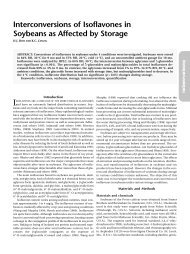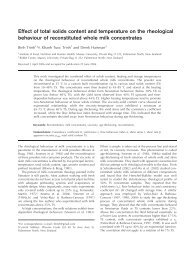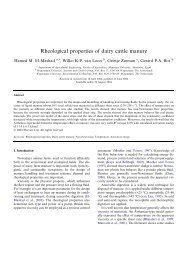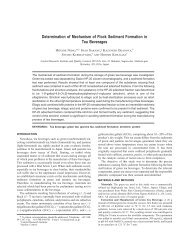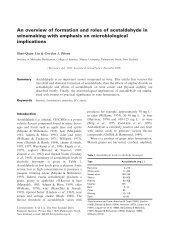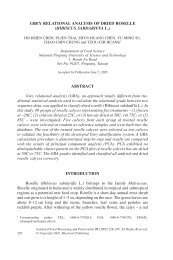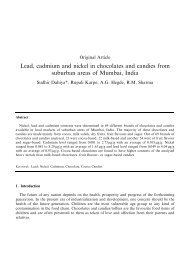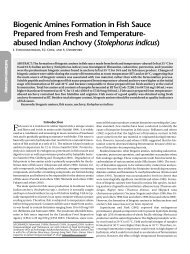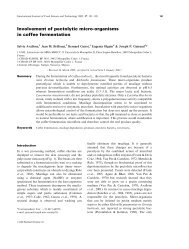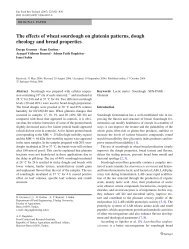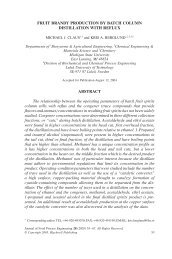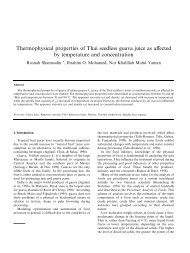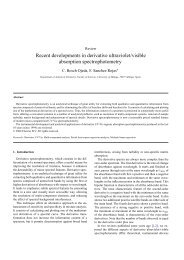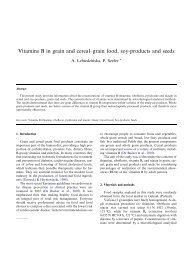Phenolic acid profiles of mangosteen fruits (Garcinia mangostana)
Phenolic acid profiles of mangosteen fruits (Garcinia mangostana)
Phenolic acid profiles of mangosteen fruits (Garcinia mangostana)
You also want an ePaper? Increase the reach of your titles
YUMPU automatically turns print PDFs into web optimized ePapers that Google loves.
<strong>Phenolic</strong> <strong>acid</strong> <strong>pr<strong>of</strong>iles</strong> <strong>of</strong> <strong>mangosteen</strong> <strong>fruits</strong> (<strong>Garcinia</strong> <strong>mangostana</strong>)<br />
Ryszard Zadernowski a , Sylwester Czaplicki a , Marian Naczk b, *<br />
a Department <strong>of</strong> Food Plant Chemistry and Processing, Faculty <strong>of</strong> Food Science, University <strong>of</strong> Warmia and Mazury, Olsztyn, Poland<br />
b Department <strong>of</strong> Human Nutrition, St. Francis Xavier University, Antigonish, NS, Canada B2G 2W5<br />
article info<br />
Article history:<br />
Received 26 May 2008<br />
Received in revised form 5 June 2008<br />
Accepted 16 June 2008<br />
Keywords:<br />
<strong>Phenolic</strong>s <strong>acid</strong>s<br />
Mangosteen<br />
<strong>Garcinia</strong> Mangostana<br />
Pr<strong>of</strong>iles<br />
Rind<br />
Aril<br />
Peel<br />
1. Introduction<br />
abstract<br />
Mangosteen (<strong>Garcinia</strong> <strong>mangostana</strong> L.), a tropical evergreen tree,<br />
may be found in Malaya, India, Thailand, Vietnam, Singapore, Philippines<br />
and Burma. It bears dark-purple to red-purple rounded<br />
<strong>fruits</strong> <strong>of</strong> 5–7 cm in diameter. The edible portion <strong>of</strong> fruit (aril) is<br />
white, s<strong>of</strong>t with a slightly sour taste (Martin, 1980; Morton,<br />
1987). The pericarp, 6–10 mm in thickness, has been used in folk<br />
medicine for the relief <strong>of</strong> diarrhea as well as for treatment <strong>of</strong> skin<br />
wounds and disorders (Mahabusarakam, Iriyachitra, & Taylor,<br />
1987; Martin, 1980; Morton, 1987). Mangosteen fruit is a rich<br />
source <strong>of</strong> phenolic compounds such as xanthones, condensed tannins<br />
and anthocyanins (Fu, Loo, Chia, & Huang, 2007; Jung, Su, Keller,<br />
Mehta, & Kinghorn, 2006; Mahabusarakam et al., 1987). Of<br />
these, only xanthones have been extensively studied by various research<br />
groups (Ji, Avula, & Khan, 2007; Jung et al., 2006; Mahabusarakam<br />
et al., 1987).<br />
The content <strong>of</strong> phenolics in <strong>fruits</strong> is affected by the degree <strong>of</strong><br />
maturity at harvest, genetic differences (cultivar), preharvest<br />
environmental conditions, post-harvest storage conditions and<br />
processing (Shahidi & Naczk, 2004). <strong>Phenolic</strong> <strong>acid</strong>s constitute<br />
about one-third <strong>of</strong> the dietary phenols and they are present in<br />
plants in the free and bound forms (Robbins, 2003). Bound-phenolics<br />
may be linked to various plant components through ester,<br />
* Corresponding author. Tel.: +1 902 867 2205; fax: +1 902 867 2389.<br />
E-mail address: mnaczk@stfx.ca (M. Naczk).<br />
The composition <strong>of</strong> phenolic <strong>acid</strong>s in various parts <strong>of</strong> <strong>mangosteen</strong> fruit (<strong>Garcinia</strong> <strong>mangostana</strong>) was determined<br />
by GC and MS. The total content <strong>of</strong> phenolic <strong>acid</strong>s, identified by GC-FID ranged from 265.7 ± 12.7<br />
(aril) to 5027.7 ± 188.0 (peel) mg per kg <strong>of</strong> dry matter <strong>of</strong> sample. Ten phenolic <strong>acid</strong>s were identified in<br />
<strong>mangosteen</strong> fruit. Of these, protocatechuic <strong>acid</strong> was the major phenolic <strong>acid</strong> in the peel and rind, while<br />
p-hydroxybenzoic <strong>acid</strong> was the predominant phenolic <strong>acid</strong> in the aril. m-Hydroxybenzoic <strong>acid</strong> was<br />
detected only in the peel, while 3,4-dihydroxymandelic was present only in the rind. The phenolic <strong>acid</strong>s<br />
liberated from esters and glycosidic bonds were the major fractions <strong>of</strong> phenolic <strong>acid</strong>s in <strong>mangosteen</strong> fruit.<br />
ether, or acetal bonds (Chalas et al., 2001). Clifford (1999) estimated<br />
that daily consumption <strong>of</strong> phenolic <strong>acid</strong>s ranged from<br />
25 mg to 1 g. An increasing interest in determining the antioxidant<br />
activities exhibited by phenolic <strong>acid</strong>s and their derivatives should<br />
also be noted (Lodovici, Guglielmi, Meoni, & Dolara, 2001; Rice-<br />
Evans, Miller, & Paganga, 1996, 1997).<br />
To the best <strong>of</strong> our knowledge phenolic <strong>acid</strong> <strong>pr<strong>of</strong>iles</strong> <strong>of</strong> <strong>mangosteen</strong><br />
<strong>fruits</strong> are still unknown. Therefore, the purpose <strong>of</strong> this study<br />
was to determine the composition <strong>of</strong> free and bound phenolic <strong>acid</strong>s<br />
in locally available <strong>mangosteen</strong> <strong>fruits</strong> using analytical methodologies<br />
established in our laboratories (Zadernowski, 1987; Zadernowski,<br />
Naczk, & Nesterowicz, 2005; Zadernowski, Naczk, &<br />
Nowak-Polakowska, 2002).<br />
2. Material and methods<br />
2.1. Materials<br />
Mangosteen <strong>fruits</strong> (<strong>Garcinia</strong> <strong>mangostana</strong>) imported from Mexico<br />
were obtained from a local food store in Antigonish, Nova Scotia,<br />
Canada. All <strong>fruits</strong> were cleaned and inspected to remove damaged,<br />
diseased or pest infested <strong>fruits</strong>. Following this the <strong>fruits</strong> were separated<br />
into three parts: the exocarp (referred here as peel), mesocarp<br />
(referred here as rind) and edible pulp (referred here as aril).<br />
Subsequently, the fruit parts were lyophilized and then stored in<br />
polyethylene bags at 20 °C until analysis. Before analysis, lyophilized<br />
fruit parts were crushed in a food processor.
2.2. Chemicals<br />
Caffeic, ferulic, p- and m-hydroxybenzoic, protocatechuic,<br />
sinapic, vanillic, and veratric <strong>acid</strong>s, as well (+) catechin, sodium<br />
bicarbonate, sodium hydroxide, diethyl ether, methanol and N,Obis(trimethylsilyl)acetamide<br />
were purchased from Sigma Chemical<br />
Co. (Sigma–Aldrich Sp. z.o.o.; Gliwice, Poland), while p-coumaric<br />
<strong>acid</strong> was obtained from Fluka (Sigma–Aldrich Sp. z.o.o.; Gliwice,<br />
Poland).<br />
2.3. Preparation <strong>of</strong> crude phenolic extract<br />
Soluble phenolics were extracted six times from crushed fruit<br />
parts into aqueous 80% (vol/vol) methanol (at a ratio <strong>of</strong> 1:1, wt/<br />
vol) at room temperature for 1 h using an orbital shaker at<br />
250 rpm. The mixture was centrifuged at 1750g for 10 min and<br />
the supernatants were collected, combined, evaporated to near<br />
dryness under vacuum at 640 °C, and lyophilized (Zadernowski,<br />
1987).<br />
2.4. Fractionation <strong>of</strong> phenolic <strong>acid</strong>s<br />
<strong>Phenolic</strong> <strong>acid</strong>s present in crude extract were fractionated into<br />
free and bound forms according to the procedure described by<br />
Kozlowska, Rotkiewicz, Zadernowski, and Sosulski (1983), Zadernowski<br />
(1987), Zadernowski, Naczk, and Nowak-Polakowska<br />
(2002) and Zadernowski, Naczk, and Nesterowicz (2005). A 0.5 g<br />
sample <strong>of</strong> dried crude phenolic extract was suspended in 50 mL<br />
<strong>of</strong> triply distilled water, <strong>acid</strong>ified to pH 2 using 6 M HCl and extracted<br />
five times with diethyl ether (1:1, vol/vol) at room temperature.<br />
The ether extracts <strong>of</strong> phenolic <strong>acid</strong>s (referred to as<br />
free phenolic <strong>acid</strong>s) were combined and evaporated to dryness<br />
under vacuum at 640 °C. The water phase was adjusted to pH 7<br />
with 2 M NaOH and then evaporated to almost dryness under<br />
vacuum at 640 °C. The residue was treated with 20 mL <strong>of</strong> 4 M<br />
NaOH under nitrogen for 4 h at room temperature. The reaction<br />
mixture was then <strong>acid</strong>ified with 6 M HCl to pH 2 and extracted<br />
with diethyl ether as described above. The ether extracts <strong>of</strong> phenolic<br />
<strong>acid</strong>s (referred to as phenolic <strong>acid</strong>s liberated from ester<br />
bonds) were combined and evaporated to dryness under vacuum<br />
at 640 °C. The water phase was adjusted to pH 7 with 2 M NaOH<br />
and then evaporated to almost dryness under vacuum at 640 °C.<br />
The residue was heated with 50 mL <strong>of</strong> 2 M HCl for 30 min at<br />
95 °C, cooled to room temperature and extracted with diethyl<br />
ether as described above. These ether extracts <strong>of</strong> phenolic <strong>acid</strong>s<br />
(referred to as phenolic <strong>acid</strong>s liberated from glycosidic bonds)<br />
were combined and evaporated to dryness under vacuum at<br />
640 °C.<br />
2.5. Purification <strong>of</strong> phenolic <strong>acid</strong>s fractions<br />
Each <strong>of</strong> the residues <strong>of</strong> phenolic <strong>acid</strong> fractions, obtained as described<br />
above, was dissolved in 50 mL <strong>of</strong> 5% (wt/vol) NaHCO3 (pH<br />
8) and extracted five times with diethyl ether to remove residual<br />
lipid material. The water phase was then <strong>acid</strong>ified with 6 M HCl<br />
to pH 2 and extracted with diethyl ether as described above. The<br />
dry residues <strong>of</strong> phenolic <strong>acid</strong>s were dissolved in 5 mL <strong>of</strong> 80%<br />
(vol/vol) methanol (Zadernowski, 1987).<br />
2.6. Formation <strong>of</strong> trimethylsilyl derivatives<br />
To 0.5 mL methanolic solution <strong>of</strong> purified phenolic <strong>acid</strong>s in the<br />
reaction vial 20–50 lL <strong>of</strong> N,O-bis(trimethylsilyl)acetamide were<br />
added, depending on the phenolic <strong>acid</strong> concentrations. The vial<br />
was then tightly closed and left at room temperature for 24 h<br />
(Zadernowski, 1987).<br />
2.7. GC–MS identification <strong>of</strong> phenolic <strong>acid</strong>s<br />
The trimethylsilyl derivatives <strong>of</strong> phenolic <strong>acid</strong>s were identified<br />
using GC–MS methodology as described by Zadernowski (1987),<br />
Zadernowski, Naczk, and Nowak-Polakowska (2002), Horman and<br />
Viani (1971), Tian and White (1994), and Xing and White (1997).<br />
GC–MS analysis was carried out on a Hewlett–Packard 5890 Series<br />
II gas chromatograph interfaced with a MS Hewlett–Packard 5970<br />
mass selective detector (Kennett Square, PA). Separations were performed<br />
using a 30 m 0.25 mm (i.d.) SPB-1 silica-fused capillary<br />
column coated with 0.25 lm film <strong>of</strong> poly(dimethylsiloxane) as the<br />
stationary phase (Supelco Inc., Bellefonte, PA). Helium was used as<br />
the carrier gas at an average flow rate <strong>of</strong> 28 cm 3 per min. The injector<br />
and the transfer line temperatures were kept at 240 °C. The oven<br />
temperature program used was 120–260 °C at a rate <strong>of</strong> 20 °C per<br />
min. Initial and final temperatures were held for 2 min and<br />
10 min, respectively. The injections were carried out in a split mode<br />
with a split ratio <strong>of</strong> 20:1. The mass spectrometer was operated with<br />
an ionization voltage <strong>of</strong> 235 eV and electron multiplier voltage <strong>of</strong><br />
1700 V and was scanned from 50 m/z to 500 m/z at 0.8 s per scan.<br />
The volume <strong>of</strong> injected samples ranged from 1 lLto2lL, depending<br />
on the sample. Caffeic, p-coumaric, ferulic, p-hydroxybenzoic, protocatechuic,<br />
vanillic and veratric (3,4-dimethoxybenzoic) <strong>acid</strong>s<br />
were identified by using mass spectra <strong>of</strong> standard derivatives. The<br />
remaining phenolic <strong>acid</strong>s (m-hydroxybenzoic, p-hydroxyphenylacetic<br />
and 3,4-dihydroxymandelic <strong>acid</strong>s) as well as other <strong>acid</strong>s<br />
(benzoic, cinnamic, mandelic (2-hydroxy-2-phenylacetic) and piperylonic<br />
(3,4-methylenedioxybenzoic) <strong>acid</strong>s) were identified using<br />
the mass spectral library provided by the GC–MS supplier.<br />
2.8. Quantitation <strong>of</strong> phenolic <strong>acid</strong>s<br />
The phenolic <strong>acid</strong>s were quantified as described by Zadernowski<br />
(1987), Zadernowski, Naczk, and Nowak-Polakowska (2002)<br />
and Zadernowski, Naczk, and Nesterowicz (2005) using a Hewlett–Packard<br />
5890 Series II (Kennett square, PA) gas chromatograph<br />
equipped with a flame–ionization detector. Separations <strong>of</strong><br />
trimethylsilyl derivatives <strong>of</strong> phenolic <strong>acid</strong>s were performed as described<br />
in the previous paragraph. Sinapic <strong>acid</strong> was used as an<br />
external standard. The contents <strong>of</strong> the phenolic <strong>acid</strong>s are expressed<br />
as mg per kg <strong>of</strong> fruit part on a dry weight basis.<br />
2.9. Chemical analysis<br />
The total phenol content in crude extracts was estimated by the<br />
Folin-Ciocalteau assay (Shahidi & Naczk, 2004) and expressed in<br />
mg (+)-catechin equivalents per kg <strong>of</strong> fruit part on dry matter basis.<br />
The moisture content was measured by drying the ground berries<br />
at 105 °C until a constant weight was obtained (AOAC, 1980).<br />
2.10. Data treatment<br />
The results presented in the tables are mean values (n = 6 and<br />
n = 3 for Table 1 and n = 3 for Tables 2–5) ±SD (standard deviation).<br />
Statistical analysis <strong>of</strong> data (ANOVA and t-test) was performed using<br />
SigmaStat v.3.0 (SSPS, Chicago, IL). Differences at P 6 0.05 were<br />
considered to be significant.<br />
3. Results and discussion<br />
3.1. Total phenols<br />
About 80% (vol/vol) aqueous methanol–water is commonly<br />
used for the extraction <strong>of</strong> phenolic <strong>acid</strong>s and their derivatives from<br />
plant materials (Naczk & Shahidi, 2004; Robbins, 2003; Zadernowski,
Table 1<br />
Total phenols and contributions <strong>of</strong> phenolic <strong>acid</strong> fractions in various parts <strong>of</strong> <strong>mangosteen</strong> fruit<br />
Sample Moisture Total phenols (TPH) Free phenolic <strong>acid</strong>s <strong>Phenolic</strong> <strong>acid</strong>s liberated from<br />
(%) (g/kg d.m. A ) (%) B<br />
Esters Glycosides<br />
Peel 43.2 ± 0.4 70.2 ± 5.7 18.7 ± 1.5 41.4 ± 1.7 a<br />
39.9 ± 3.7 a<br />
Rind 60.0 ± 3.0 218.1 ± 18.0 5.5 ± 0.5 49.7 ± 4.2 a<br />
44.8 ± 4.0 a<br />
Aril 82.6 ± 0.2 6.4 ± 0.5 9.7 ± 1.3 76.5 ± 5.0 13.8 ± 3.3<br />
Values for the same column marked by the same superscript letter are not significantly different (TPH: n = 6; ANOVA and t-test; P > 0.05; phenolic <strong>acid</strong>s: n = 3; ANOVA and ttest;<br />
P > 0.05).<br />
A<br />
g (+)-catechin equivalents per kg <strong>of</strong> dry matter <strong>of</strong> sample.<br />
B<br />
% <strong>of</strong> the total phenolic <strong>acid</strong>s as determined by GC-FID methodology.<br />
Table 2<br />
Total phenolic <strong>acid</strong> contents in various parts <strong>of</strong> <strong>mangosteen</strong> <strong>fruits</strong> [mg per kg <strong>of</strong> dry<br />
matter <strong>of</strong> sample]<br />
Acid Peel Rind Aril<br />
Hydroxybenzoic <strong>acid</strong> derivatives (HBA)<br />
m-Hydroxybenzoic B<br />
68.1 ± 4.6 – A<br />
–<br />
p-Hydroxybenzoic B<br />
510.7 ± 37.2 941.4 ± 68.7 142.6 ± 10.8<br />
Protocatechuic B<br />
3812.2 ± 181.8 2301.3 ± 172.1 94.0 ± 6.3<br />
Vanillic B<br />
414.3 ± 27.3 163.9 ± 11.6 9.5 ± 1.3<br />
Veratric B<br />
84.3 ± 7.0 – –<br />
Hydroxycinnamic <strong>acid</strong> derivatives (HCA)<br />
Caffeic B<br />
91.6 ± 6.0 – –<br />
p-Coumaric B<br />
– 59.7 ± 4.9 18.7 ± 2.0<br />
Ferulic B<br />
12.0 ± 1.0 – 0.9 ± 0.0<br />
Other phenolic <strong>acid</strong>s (OtherPA)<br />
p-Hydroxyphenylacetic 34.5 ± 4.0 22.9 ± 3.0 –<br />
3,4-Dihydroxymandelic<br />
Other <strong>acid</strong>s (otherA)<br />
– 88.7 ± 9.5 –<br />
Benzoic B<br />
24.5 ± 3.0 a<br />
– 26.1 ± 3.0 a<br />
Cinnamic B<br />
27.9 ± 2.3 – 1.9 ± 0.2<br />
Mandelic 7.4 ± 0.5 – –<br />
Piperonylic 203.3 ± 16.3 – –<br />
Total HBA 4889.6 ± 187.8 3406.6 ± 185.7 246.1 ± 12.5<br />
Total HCA 103.6 ± 6.1 59.7 ± 4.9 19.6 ± 2.0<br />
Total otherPA 34.5 ± 4.0 111.6 ± 10.0 –<br />
Total PA 5027.7 ± 188.0 3577.9 ± 188.1 265.7 ± 12.7<br />
Total otherA 263.1 ± 16.7 – 28.0 ± 3.0<br />
Values in each row marked by the same superscript letter are not significantly<br />
different (n = 3; ANOVA and t-test; P > 0.05).<br />
A Not detected.<br />
B Identified using the mass spectrum <strong>of</strong> the standard derivative.<br />
Table 3<br />
Free phenolic <strong>acid</strong>s content in various parts <strong>of</strong> <strong>mangosteen</strong> fruit (mg per kg <strong>of</strong> dry<br />
matter <strong>of</strong> sample)<br />
Acid Peel Rind Aril<br />
Hydroxybenzoic <strong>acid</strong> derivatives (HBA)<br />
p-Hydroxybenzoic B<br />
88.7 ± 10.2 – A<br />
5.2 ± 0.8<br />
Protocatechuic B<br />
510.7 ± 60.0 153.5 ± 12.4 –<br />
Vanillic B<br />
286.0 ± 25.9 65.6 ± 5.6 0.8 ± 0.00<br />
Veratric B<br />
– – –<br />
Hydroxycinnamic <strong>acid</strong> derivatives (HCA)<br />
Caffeic B<br />
53.6 ± 4.5 – –<br />
p-Coumaric B<br />
– – 18.7 ± 2.0<br />
Ferulic B<br />
– – 0.9 ± 0.00<br />
Other <strong>acid</strong>s (otherA)<br />
Cinnamic B<br />
– – 1.9 ± 0.2<br />
Piperonylic 146.2 ± 15.9 – –<br />
Total HBA 885.6 ± 66.1 219.1 ± 13.6 6.0 ± 0.8<br />
Total HCA 53.6 ± 4.5 – 19.6 ± 2.0<br />
Total otherPA – – –<br />
Total PA 939.2 ± 66.3 219.1 ± 13.6 25.6 ± 2.2<br />
Total otherA 146.2 ± 15.9 – 1.9 ± 0.2<br />
A Not detected.<br />
B Identified using the mass spectrum <strong>of</strong> the standard derivative.<br />
(%) B<br />
Table 4<br />
Content <strong>of</strong> phenolic <strong>acid</strong>s liberated from esters in various parts <strong>of</strong> <strong>mangosteen</strong> fruit<br />
(mg per kg <strong>of</strong> dry matter <strong>of</strong> sample)<br />
Acid Peel Rind Aril<br />
Hydroxybenzoic <strong>acid</strong> derivatives (HBA)<br />
m-Hydroxybenzoic B<br />
30.3 ± 2.5 – A<br />
–<br />
p-Hydroxybenzoic B<br />
220.0 ± 30.5 416.2 ± 40.0 122.7 ± 10.6<br />
Protocatechuic B<br />
1635.9 ± 15.9 1191.6 ± 110.8 72.0 ± 6.0<br />
Vanillic B<br />
54.5 ± 6.4 – 8.7 ± 0.9<br />
Veratric B<br />
56.4 ± 5.9 – –<br />
Hydroxycinnamic <strong>acid</strong> derivatives (HCA)<br />
Caffeic B<br />
38.0 ± 4.0 – –<br />
p-Coumaric B<br />
– 59.7 ± 4.9 –<br />
Ferulic<br />
Other phenolic <strong>acid</strong>s (otherPA)<br />
12.0 ± 1.0 – –<br />
p-Hydroxyphenylacetic 34.5 ± 4.0 – –<br />
3,4-Dihydroxymandelic<br />
Other <strong>acid</strong>s (OtherA)<br />
– 88.7 ± 9.5 –<br />
Benzoic B<br />
24.5 ± 3.0 a<br />
– 26.1 ± 3.0 a<br />
Cinnamic B<br />
27.9 ± 2.3 – –<br />
Mandelic 7.4 ± 0.5 – –<br />
Piperonylic 28.2 ± 3.0 – –<br />
Total HBA 1997.1 ± 35.6 1607.8 ± 117.8 203.4 ± 12.2<br />
Total HCA 50.0 ± 4.1 59.7 ± 4.9 –<br />
Total otherPA 34.5 ± 4.0 88.7 ± 9.5 –<br />
Total PA 2081.6 ± 36.1 1756.2 ± 118.3 203.4 ± 12.2<br />
Total otherA 88.0 ± 4.9 – 26.1 ± 3.0<br />
Values in each row marked by the same superscript letter are not significantly<br />
different (n =3;t-test; P > 0.05).<br />
A Not detected.<br />
B Identified using the mass spectrum <strong>of</strong> the standard derivative.<br />
Table 5<br />
Content <strong>of</strong> phenolic <strong>acid</strong>s liberated from glycosides in various parts <strong>of</strong> <strong>mangosteen</strong><br />
fruit (mg per kg <strong>of</strong> dry matter)<br />
Acid Peel Rind Aril<br />
Hydroxybenzoic <strong>acid</strong> derivatives (HBA)<br />
m-Hydroxybenzoic B<br />
37.8 ± 3.9 – A<br />
–<br />
p-Hydroxybenzoic B<br />
202.0 ± 18.7 525.2 ± 55.9 14.7 ± 1.7<br />
Protocatechuic B<br />
1665.5 ± 170.9 956.2 ± 102.1 22.0 ± 2.0<br />
Vanillic B<br />
73.8 ± 5.9 98.3 ± 10.2 8.7 ± 1.0<br />
Veratric B<br />
27.9 ± 3.8 – –<br />
(%) B<br />
Other phenolic <strong>acid</strong>s (otherPA)<br />
p-Hydroxyphenylacetic – 22.9 ± 3.0 –<br />
Other <strong>acid</strong>s (otherA)<br />
Piperonylic 28.9 ± 2.0 – –<br />
Total HBA 2007.0 ± 172.1 1579.7 ± 116.8 45.4 ± 2.8<br />
Total otherPA – 22.9 ± 3.0<br />
Total PA 2007.0 ± 172.1 1579.7 ± 116.9 45.4 ± 2.8<br />
Total otherA 28.9 ± 2.0 – –<br />
A Not detected.<br />
B Identified using the mass spectrum <strong>of</strong> the standard derivative.
1987; Zadernowski, Naczk, and Nowak-Polakowska, 2002) and<br />
therefore, was selected for extraction <strong>of</strong> phenolics from <strong>mangosteen</strong><br />
<strong>fruits</strong>. Table 1 shows the moisture and total phenol (TPH)<br />
contents in <strong>mangosteen</strong> fruit parts. In the literature, the reported<br />
TPH values are calculated per fresh weight <strong>of</strong> fruit or per dry matter<br />
<strong>of</strong> fruit. Moisture contents are provided here in order to aid the<br />
readers in comparing our results with those published. TPH values<br />
ranged from 6400 in the aril to over 218.1 g <strong>of</strong> (+)-catechin equivalents<br />
per kg <strong>of</strong> sample (dry matter; d.m.) in the rind (Table 1). The<br />
rind contains over threefold more TPH than the peel, while the edible<br />
aril is a very poor source <strong>of</strong> phenolics. The total phenols reported<br />
here are higher than those previously published for aril<br />
(Lim, Lim, & Tee, 2007) and peels (Maisuthisakul, Suttajit, & Pongsawatmanit,<br />
2007). Factors such as regional differences, harvest<br />
time, storage conditions, and analytical procedures used for extraction<br />
and quantification <strong>of</strong> phenolics might contribute to these differences<br />
(Shahidi & Naczk, 2004).<br />
3.2. Total phenolic <strong>acid</strong>s<br />
Many analytical procedures have been employed for the determination<br />
<strong>of</strong> phenolic compounds in plant materials (Antolovich,<br />
Prenzler, Robards, & Ryan, 2000; Robbins, 2003) but those currently<br />
used for the determination <strong>of</strong> plant phenolics only target<br />
major flavonoids and/or phenolic <strong>acid</strong>s and their conjugates<br />
(Kähkönen, Hopla, & Heinonen, 2001; Thompson & Chaovanalikit,<br />
2003). The total content <strong>of</strong> phenolic <strong>acid</strong>s in <strong>mangosteen</strong> berries<br />
ranged from 265.7 ± 12.9 (aril) to 5027.7 ± 188.0 mg per kg, d.m.,<br />
(peel) (Table 2). The phenolic <strong>acid</strong>s are mainly located in the pericarp<br />
<strong>of</strong> <strong>mangosteen</strong> fruit. The peel, rind and aril <strong>of</strong> the <strong>mangosteen</strong><br />
fruit contain eight, six and five phenolic <strong>acid</strong>s, respectively.<br />
Hydroxybenzoic <strong>acid</strong> derivatives constituted from 92.6% (aril) to<br />
97.3% (peel) <strong>of</strong> the total phenolic <strong>acid</strong>s present. Of these, mhydroxybenzoic,<br />
veratric and caffeic <strong>acid</strong>s were only found in the<br />
peel and 3, 4-dihydroxymandelic <strong>acid</strong> in the rind. Protocatechuic<br />
<strong>acid</strong> was the major phenolic <strong>acid</strong> found in the peel and rind <strong>of</strong><br />
the <strong>mangosteen</strong> fruit and this <strong>acid</strong> comprised 75.8% and 64.3% <strong>of</strong><br />
the total phenolic <strong>acid</strong>s present in these fruit parts, respectively.<br />
On the other hand, p-hydroxybenzoic and protocatechuic <strong>acid</strong>s,<br />
the major phenolic <strong>acid</strong>s found in the aril, constituted 53.7% and<br />
35.4% <strong>of</strong> the total phenolic <strong>acid</strong>s present in the aril, respectively.<br />
In addition, the peel and aril contained 263.1 ± 16.7 and<br />
28.0 ± 3.0 mg per kg, d.m. <strong>of</strong> other <strong>acid</strong>s (such as benzoic, cinnamic,<br />
mandelic and piperonylic), respectively (Table 2).<br />
3.3. Free phenolic <strong>acid</strong>s<br />
Free phenolic <strong>acid</strong>s comprised from 5.5% (rind) to 18.7% (peel)<br />
<strong>of</strong> the total phenolic <strong>acid</strong>s present in <strong>mangosteen</strong> <strong>fruits</strong> (Table 1).<br />
Hydroxybenzoic <strong>acid</strong> derivatives were the major phenolic <strong>acid</strong>s<br />
found in the peel and rind, while hydroxycinnamic <strong>acid</strong> derivatives<br />
dominated in the aril. Only six phenolic <strong>acid</strong>s were identified in<br />
this fraction (Table 3). Of these, protocatechuic and vanillic were<br />
the major phenolic <strong>acid</strong>s in the peel and rind, while p-coumaric<br />
<strong>acid</strong> was dominant in the aril. Furthermore, caffeic <strong>acid</strong> was detected<br />
only in the peel, while p-hydroxybenzoic <strong>acid</strong> was found<br />
in both the peel and aril. The levels <strong>of</strong> individual phenolic <strong>acid</strong>s<br />
in the aril, however, did not exceed their taste thresholds reported<br />
in the literature (Maga & Lorenz, 1973). Thus, the fraction <strong>of</strong> free<br />
phenolic <strong>acid</strong>s may not make a significant contribution to the aril<br />
flavour. Bunsiri, Ketsa, & Paull 2003) tentatively identified two free<br />
phenolic <strong>acid</strong>s, namely sinapic and p-coumaric <strong>acid</strong>s, in the pericarp<br />
<strong>of</strong> <strong>mangosteen</strong> fruit. These phenolics are involved with lignin<br />
synthesis in <strong>mangosteen</strong> pericarp leading to its hardening. Rapid<br />
decrease in the content <strong>of</strong> these phenolic <strong>acid</strong>s was noticed in<br />
<strong>fruits</strong> subjected to mechanical impact. The rate <strong>of</strong> the disappear-<br />
ance these phenolic <strong>acid</strong>s was, however, enhanced by fruit maturity<br />
and the presence <strong>of</strong> oxygen. In this study, we did not detect<br />
sinapic and p-coumaric <strong>acid</strong>s in the free phenolic <strong>acid</strong>s fraction isolated<br />
from either the peel or the rind.<br />
3.4. Bound phenolic <strong>acid</strong>s<br />
Bound phenolic <strong>acid</strong>s were the predominant phenolic <strong>acid</strong>s in<br />
<strong>mangosteen</strong> <strong>fruits</strong>. <strong>Phenolic</strong> <strong>acid</strong>s liberated from soluble esters<br />
comprised from 41.4% (peel) to 76.5% (aril) <strong>of</strong> the total phenolic<br />
<strong>acid</strong>s present in the <strong>fruits</strong> (Table 1). Hydroxybenzoic <strong>acid</strong> derivatives<br />
comprised from 91.5% (rind) to 100% (aril) <strong>of</strong> phenolic <strong>acid</strong>s<br />
identified in this fraction (Table 4). Of these, protocatechuic <strong>acid</strong><br />
was the major phenolic <strong>acid</strong> in the peel and rind, while protocatechuic<br />
and p-coumaric dominated in the aril. m-Hydroxybenzoic,<br />
vanillic and veratric <strong>acid</strong>s were unique, but minor phenolic <strong>acid</strong>s<br />
in the peel. Furthermore, caffeic, ferulic and p-hydroxyphenylacetic<br />
<strong>acid</strong> were only detected in the peel, while p-coumaric and 3,<br />
4-dihydroxymandelic <strong>acid</strong>s were unique to the rind.<br />
<strong>Phenolic</strong> <strong>acid</strong>s linked to sugars by glycosidic bonds comprised<br />
from 13.8% (aril) to 44.8% (rind) <strong>of</strong> the total phenolic <strong>acid</strong>s present<br />
in these <strong>fruits</strong> (Table 1). Hydroxybenzoic <strong>acid</strong> derivatives were the<br />
only class <strong>of</strong> phenolic <strong>acid</strong>s found in this fraction. Table 5 shows<br />
the phenolic <strong>acid</strong> <strong>pr<strong>of</strong>iles</strong> for this fraction. Sugar moieties <strong>of</strong> glycosides<br />
were not identified in this study. Protocatechuic <strong>acid</strong> was the<br />
principal phenolic <strong>acid</strong> present in the peel, while p-hydroxybenzoic<br />
and protocatechuic <strong>acid</strong>s were the major phenolic <strong>acid</strong>s in the<br />
rind and aril. Moreover, m-hydroxybenzoic and veratric <strong>acid</strong>s were<br />
only found in the peel, while p-hydroxyphenylacetic <strong>acid</strong> was only<br />
detected in the rind.<br />
In conclusion, the results <strong>of</strong> this study indicate that phenolic<br />
<strong>acid</strong>s are mainly located in the pericarp <strong>of</strong> <strong>mangosteen</strong> and that<br />
hydroxybenzoic <strong>acid</strong> derivatives are the major phenolic <strong>acid</strong>s<br />
found in these <strong>fruits</strong>. The total content <strong>of</strong> phenolic <strong>acid</strong>s in the<br />
<strong>mangosteen</strong> pericarp is similar to that reported for small berries.<br />
On the other hand, the edible aril contains up to 20 times less phenolic<br />
<strong>acid</strong>s than small berries (Zadernowski, Naczk, & Nesterowicz,<br />
2005). Free phenolic <strong>acid</strong>s comprised only up to 20% <strong>of</strong> total phenolic<br />
<strong>acid</strong>s. More research is still needed in order to establish the<br />
effect <strong>of</strong> the cultivar, preharvest environmental conditions, degree<br />
<strong>of</strong> maturity at harvest, post-harvest storage conditions and processing<br />
on phenolic <strong>acid</strong> <strong>pr<strong>of</strong>iles</strong> <strong>of</strong> <strong>mangosteen</strong> <strong>fruits</strong>.<br />
Acknowledgment<br />
Marian Naczk thanks the Natural Sciences and Engineering Research<br />
Council (NSERC) <strong>of</strong> Canada for support in the form <strong>of</strong> a discovery<br />
Grant.<br />
References<br />
Antolovich, M., Prenzler, P., Robards, K., & Ryan, D. (2000). Sample preparation in<br />
the determination <strong>of</strong> phenolic compounds in <strong>fruits</strong>. Analyst, 125, 989–1009.<br />
AOAC (1980). Official methods <strong>of</strong> analysis (13th ed.). Washigton DC: Association <strong>of</strong><br />
Official Analytical Chemists.<br />
Bunsiri, A., Ketsa, S., & Paull, R. E. (2003). <strong>Phenolic</strong> metabolism and lignin synthesis<br />
in damaged pericarp <strong>of</strong> <strong>mangosteen</strong> fruit after impact. Postharvest Biology and<br />
Technology, 29, 61–71.<br />
Chalas, J., Claise, C., Edeas, M., Messaoudi, C., Vergnes, L., Abella, A., et al. (2001).<br />
Effect <strong>of</strong> ethyl esterification <strong>of</strong> phenolic <strong>acid</strong>s on low-density lipoprotein<br />
oxidation. Biomedicine and Pharmacotherapy, 55, 54–60.<br />
Clifford, M. N. (1999). Chlorogenic <strong>acid</strong>s and other cinnamates-nature, occurrence,<br />
and dietary burden. Journal <strong>of</strong> the Science <strong>of</strong> Food and Agriculture, 79, 362–372.<br />
Fu, C., Loo, A. E. K., Chia, P. P., & Huang, D. (2007). Oligomeric proanthocyanidins<br />
from <strong>mangosteen</strong> pericarps. Journal <strong>of</strong> Agricultural and Food Chemistry, 55,<br />
7689–7694.<br />
Horman, I., & Viani, R. (1971). Plant polyphenols and related compounds A massspectrometric<br />
study <strong>of</strong> the trimethylsilyl derivatives <strong>of</strong> hydroxy- and/or<br />
methoxy-substituted cinnamic <strong>acid</strong>s and <strong>of</strong> their methyl esters. Organic Mass<br />
Spectrometry, 5, 203–219.
Ji, X., Avula, B., & Khan, I. A. (2007). Quantitative and qualitative datermination <strong>of</strong><br />
six xanthones in <strong>Garcinia</strong> <strong>mangostana</strong> L By LC-PDA and LC-ESI-MS. Journal <strong>of</strong><br />
Pharmaceutical and Biomedical Analysis, 43, 1270–1276.<br />
Jung, H.-A., Su, B.-N., Keller, W. J., Mehta, R. G., & Kinghorn, D. (2006). Antioxidant<br />
xanthones from the pericarp <strong>of</strong> <strong>Garcinia</strong> <strong>mangostana</strong> (<strong>mangosteen</strong>). Journal <strong>of</strong><br />
Agricultural and Food Chemistry, 54, 2077–2082.<br />
Kähkönen, M. P., Hopla, A. I., & Heinonen, M. (2001). Berry phenolics and their<br />
antioxidant activity. Journal <strong>of</strong> Agricultural and Food Chemistry, 49, 4076–4082.<br />
Kozlowska, H., Rotkiewicz, D. A., Zadernowski, R., & Sosulski, F. W. (1983). <strong>Phenolic</strong><br />
<strong>acid</strong>s in rapeseed and mustard. Journal <strong>of</strong> the American Oil Chemist’s Society, 60,<br />
1119–1123.<br />
Lim, Y. Y., Lim, T. T., & Tee, J. J. (2007). Antioxidant properties <strong>of</strong> several tropical<br />
<strong>fruits</strong>: A comparative study. Food Chemistry, 103, 1003–1008.<br />
Lodovici, M., Guglielmi, F., Meoni, M., & Dolara, P. (2001). Effect <strong>of</strong> natural phenolic<br />
<strong>acid</strong>s on DNA oxidation in vitro. Food and Chemical Toxicology, 39, 1205–1210.<br />
Maga, J., & Lorenz, K. (1973). Taste thresholds for phenolic <strong>acid</strong>s which can influence<br />
flavor properties <strong>of</strong> certain flours, grains and oilseeds. Cereal Science Today, 18,<br />
326–329.<br />
Mahabusarakam, W., Iriyachitra, P., & Taylor, W. C. (1987). Chemical constituents <strong>of</strong><br />
<strong>Garcinia</strong> <strong>mangostana</strong>. Journal <strong>of</strong> Natural Products, 50, 474–478.<br />
Maisuthisakul, P., Suttajit, M., & Pongsawatmanit, R. (2007). Assessment <strong>of</strong> phenolic<br />
content and free radical-scavenging capacity <strong>of</strong> some Thai indigenous plants.<br />
Food Chemistry, 100, 1409–1418.<br />
Martin, F. W. (1980). Durian and <strong>mangosteen</strong>. In S. Nagy & D. S. Shaw (Eds.), Tropical<br />
and subtropical <strong>fruits</strong>: Composition, properties and uses (pp. 407–414). Westport,<br />
CT: AVI Publishing.<br />
Morton, J. (1987). Mangosteen: <strong>Garcinia</strong> <strong>mangostana</strong> L. In F. Julia (Ed.), Fruits in<br />
warm climates (pp. 301–304). Miami, FL: Morton.<br />
Naczk, M., & Shahidi, F. (2004). Extraction and analysis <strong>of</strong> phenolics in food. Journal<br />
<strong>of</strong> Chromatography A, 1054, 95–111.<br />
Rice-Evans, C. A., Miller, N. J., & Paganga, G. (ce-Evans et al., 1997). Antioxidant<br />
properties <strong>of</strong> phenolic compounds. Trends in Plant Science, 2, 152–159.<br />
Rice-Evans, C. A., Miller, N. J., & Papanga, G. (ce-Evans et al., 1996). Structureantioxidant<br />
activity relationships <strong>of</strong> flavonoids and phenolic <strong>acid</strong>s. Free<br />
Radicical Biology and Medicine, 20, 933–956.<br />
Robbins, R. J. (2003). <strong>Phenolic</strong> <strong>acid</strong>s in foods: An overview <strong>of</strong> analytical<br />
methodology. Journal <strong>of</strong> Agricultural and Food Chemistry, 51, 2866–2887.<br />
Shahidi, F., & Naczk, M. (2004). <strong>Phenolic</strong>s in food and nutraceuticals. Boca Raton, FL:<br />
CRC Press (pp. 131–155, 490).<br />
Thompson, M. M., & Chaovanalikit, A. (2003). Preliminary observations on<br />
adaptation and nutraceutical values <strong>of</strong> blue honeysuckle (Lonicera caerulea) in<br />
Oregon, USA. Acta Horticulturae, 626, 65–74.<br />
Tian, L. L., & White, P. J. (1994). Antioxidant activity <strong>of</strong> oat extract in soybean<br />
and cottonseed oils. Journal <strong>of</strong> the American Oil Chemist’s Society, 71,<br />
1079–1086.<br />
Xing, Y., & White, P. J. (1997). Identification and function <strong>of</strong> antioxidants<br />
from oat groats and hulls. Journal <strong>of</strong> the American Oil Chemist’s Society, 74,<br />
303–307.<br />
Zadernowski, R. (1987). Studies on phenolic compounds <strong>of</strong> rapeseed flour. Acta<br />
Academiae Agriculturae Technicae Olsteniensis Technologia Alimentorum,<br />
Supplementum F, 1987(21), 3–55.<br />
Zadernowski, R., Naczk, M., & Nesterowicz, J. (2005). <strong>Phenolic</strong> <strong>acid</strong> <strong>pr<strong>of</strong>iles</strong> in small<br />
berries. Journal <strong>of</strong> Agricultural and Food Chemistry, 53, 2118–2124.<br />
Zadernowski, R., Naczk, M. , & Nowak-Polakowska, H. (2002). <strong>Phenolic</strong> <strong>acid</strong>s <strong>of</strong><br />
borage (Borago <strong>of</strong>ficinalis L) and evening primrose (Oenothera biennis L.). Journal<br />
<strong>of</strong> the American Oil Chemist’s Society, 79, 335–338.



